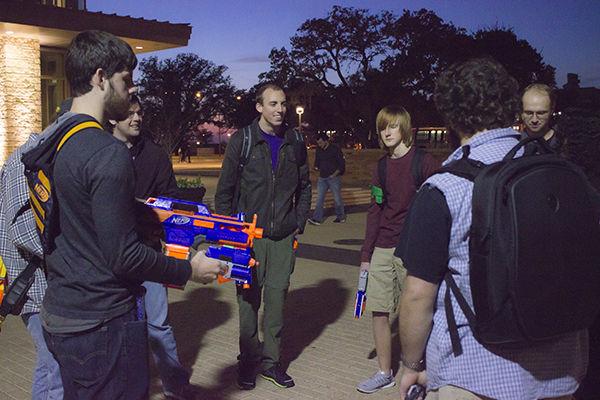The possibility of a zombie apocalypse has been romanticized by popular culture, depicting the last human survivors banding together to save the human race and blowing up brain-eating undead creatures in the process.
But these aren’t scenes that take place strictly on “The Walking Dead” — these scenes are played out at least twice per semester on campus.
The Urban Gaming Society kicks off (un)Dead Week each year with a game of Zombies vs. Humans which can be quite an epic event, as one of this year’s moderators, general studies junior Thomas Moon, explains.
“The easiest way to think about it is a giant game of tag,” Moon said. “If you get tagged, you become a zombie. We play for a week at a time, and as the week goes on there are more zombies and less humans.”
Each game begins with several original zombies, OZs, whose identities are unknown to the human players. For the first 24 hours of play, these OZs are allowed to tag any human player to get them to turn without identifying themselves with the bandana they are later required to wear. Every night for the rest of the week, the human team is assigned missions from the moderators of the game that require them to enter the danger zone and risk being tagged and turned into an undead. Armed with nerf guns and “grenades” made of bundled-up socks, the humans set out each night to take back a piece of their world.
The missions fit into a backstory created by the moderators, many inspired by pop culture, such as this semester’s initial mission that pays tribute to “Les Miserables.” Moon said some are even inspired by everyday life at A&M.
“We want to have some type of background,” Moon said. “Back when everyone was complaining about the food, one storyline was that the zombies were becoming zombies because they ate at Sbisa. So they had to get barricades and set them up around Sbisa and ‘destroy’ it so the zombies couldn’t come out anymore.”
The humans aren’t out of the woods when the missions are complete, however. Each day, passing periods become a war zone as the humans that have survived each mission try to avoid turning by shooting the zombies with Nerf guns or throwing sock grenades at them to incapacitate them anywhere from 30 seconds to 30 minutes.
Corrine Baumgartner, biomedical sciences senior and another moderator, said this onslaught is constant and the game can take a turn at any time.
“It runs all day every day,” Baumgartner said. “The zombies are constantly hunting the humans from midnight on Monday all the way to Saturday or Sunday.”
For the players, such as computer engineering junior Cory Maughmer, the game provides much-needed relief from the pressures of finals and the end of the semester.
“I’ve played humans versus zombies since fall of 2012,” Maughmer said. “I’m basically a big kid, so getting to run around with a nerf gun is a blast. It’s a really good way to blow off steam during finals.”
For those that aren’t into the undead, Baumgartner said the Urban Gaming Society has other options throughout the semester.
“We have the Hunger Games, where people bring Nerf blasters and foam melee weapons and there’s a free-for-all fight to the death until there’s one standing,” Baumgartner said. “We also have Pro Bending from ‘The Legend of Korra,’ which is basically a huge game of dodgeball with a few different elements.”
For now, though, Urban Gaming Society is dedicated to bringing zombies out of books and television and onto campus.
Humans vs. Zombies
December 8, 2014

Vanessa Peña — THE BATTALION
The “human group” in A&M’s Humans vs. Zombies meets at Rudder Plaza on Monday to discuss its strategy for the evening’s match.
0
Donate to The Battalion
$2790
$5000
Contributed
Our Goal
Your donation will support the student journalists of Texas A&M University - College Station. Your contribution will allow us to purchase equipment and cover our annual website hosting costs, in addition to paying freelance staffers for their work, travel costs for coverage and more!
More to Discover









